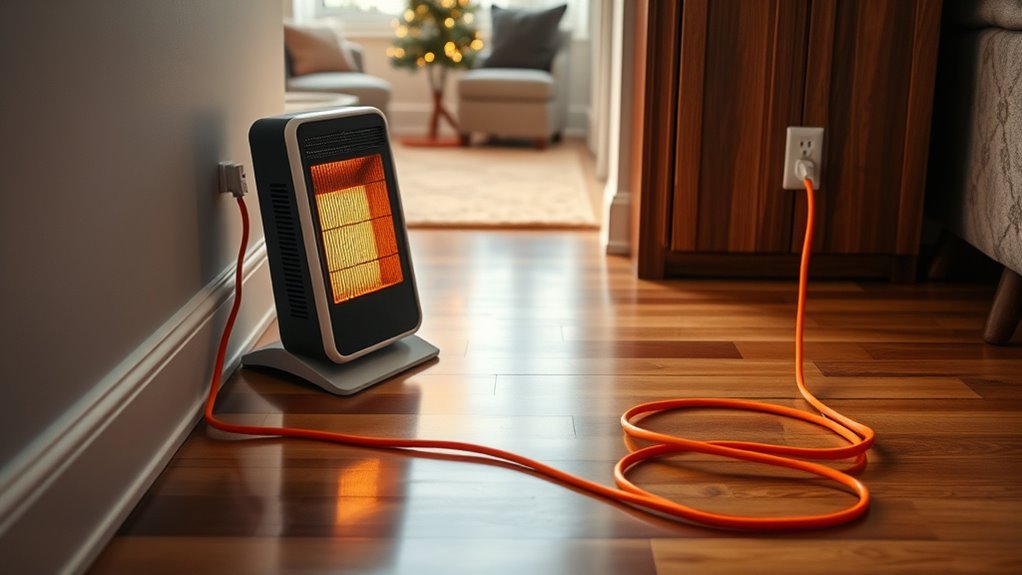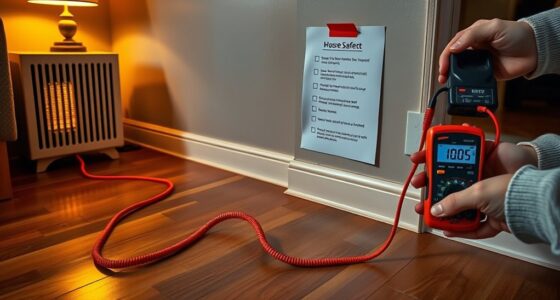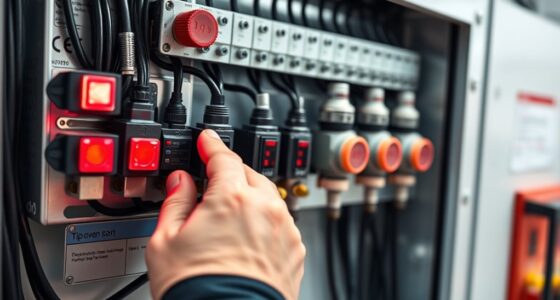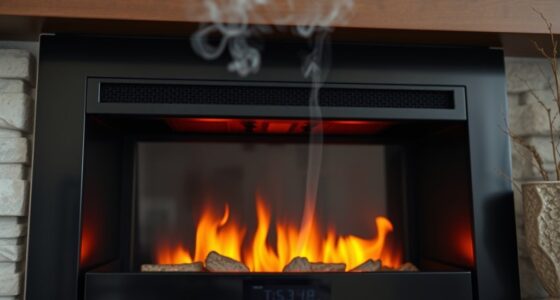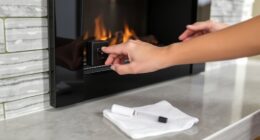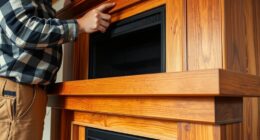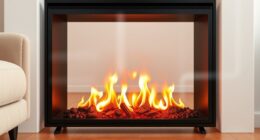To keep your heater safe, select extension cords with proper ratings, bright color for visibility, and suited for indoor use. Always check the ampacity and wattage limits to prevent overheating, and avoid connecting multiple cords together. Keep cords free from damage, away from foot traffic, and stored properly when not in use. For outdoor heaters, use weather-rated cords and secure them well. Following these tips helps prevent hazards—continue exploring for more safety essentials.
Key Takeaways
- Choose extension cords rated for indoor use, appropriate length, and with sufficient ampacity to prevent overheating.
- Keep cords flat, away from foot traffic, furniture, and hazards; avoid pinching or damaging insulation.
- Never connect multiple extension cords together or overload them beyond their rated capacity.
- Regularly inspect cords for damage, wear, or fraying; replace damaged cords immediately.
- Use outdoor-rated cords for exterior heaters; store them properly and shield from moisture and sunlight.
Choosing the Right Extension Cord for Heaters

When selecting an extension cord for your heater, it’s essential to prioritize safety and proper function. First, consider the cord length; it should be long enough to reach your outlet comfortably without creating tension or tripping hazards. Avoid excessively long cords, as they can cause voltage drops and overheating. Next, pay attention to the cord color. Bright colors like yellow or orange are easier to spot, reducing the risk of tripping or accidental disconnection. Darker cords may blend into the background, increasing hazards. Always choose a cord designed for indoor use and rated for the power your heater requires. Properly matching cord length and color not only enhances safety but also ensures your heater performs efficiently and reliably.
Understanding Power Ratings and Ampacity Limits

Understanding power ratings and ampacity limits is essential for safe extension cord use. Your extension cord’s power rating indicates the maximum electrical load it can handle safely, so always verify this before plugging in a heater. Ampacity limits specify the maximum current the cord’s wiring and insulation can support without overheating. Ensuring voltage compatibility between your outlet, heater, and extension cord prevents electrical hazards. Additionally, the cord insulation must be rated for the wattage and environmental conditions—exposed or damaged insulation increases risk. Never exceed the cord’s rated capacity, as doing so can cause overheating, fires, or electrical shock. Properly rated HEPA filtration in your devices ensures safe and effective operation, preventing the buildup of pollutants that could compromise safety. By understanding these ratings, you ensure your heater operates safely and efficiently, avoiding potential hazards linked to overloading and incompatible electrical components.
Proper Placement and Usage of Extension Cords With Heaters
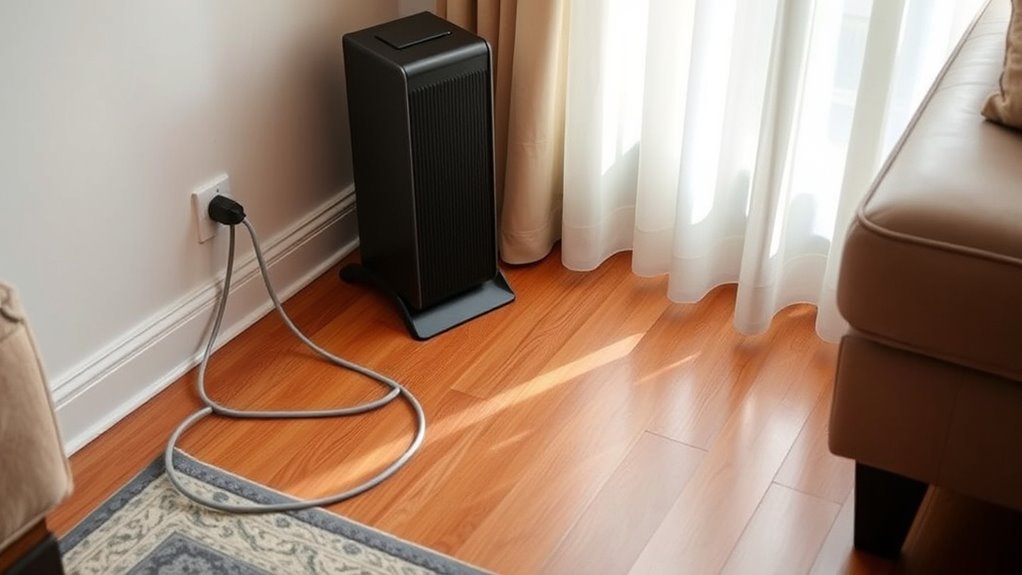
When using extension cords with heaters, make sure to keep the cords clear of furniture and foot traffic to prevent tripping hazards. Always choose heavy-duty extension cords designed to handle the power load of your heater. Proper placement guarantees safety and helps prevent overheating or electrical fires. Additionally, selecting cords with appropriate power handling capacity ensures they can safely support the heater’s electrical demand.
Keep Cords Clear of Obstructions
To prevent fire hazards and electrical accidents, it’s essential to keep extension cords clear of obstructions, especially when used with heaters. Avoid cord entanglements by routing cords away from areas where they can be stepped on or tripped over. Keep cords stretched out straight and avoid looping or knots, which can cause overheating. Proper extension cord storage is crucial; coil cords loosely and store them in a safe, dry place when not in use. Never run cords under rugs, furniture, or through doorways, as this can damage the insulation and increase fire risk. Regularly inspect cords for damage and replace any frayed or worn ones immediately. Maintaining clear, unobstructed cords ensures safe operation and reduces the chance of accidents. Incorporating natural materials such as wood or linen into your workspace can also help create a safer environment by minimizing clutter and hazards.
Use Heavy-Duty Extension Cords
Using heavy-duty extension cords is vital when powering heaters, as they are designed to handle higher electrical loads safely. Always choose cords that meet grounding requirements to prevent electrical shocks and guarantee safety. Check the cord’s label for appropriate wattage capacity, making sure it can support your heater’s power needs. Avoid using cords that are too long, as excessive cord length can lead to voltage drops and overheating; stick to recommended length limitations. Proper placement is essential—lay cords flat, away from foot traffic, and avoid pinching or damaging the insulation. Using the right heavy-duty extension cord helps prevent electrical hazards, keeps your heater operating efficiently, and reduces the risk of fire or shock. Additionally, understanding the reliability of heat pumps can help you choose safer, more efficient heating solutions for your home.
Avoiding Overloading and Multiple Extension Cords

Overloading extension cords can lead to overheating and pose serious fire hazards. To prevent this, avoid connecting multiple cords together, as this increases the risk of overloading and reduces grounding safety. Always choose a cord with the appropriate power rating for your heater, and don’t exceed its capacity. Consider cord length carefully; longer cords can cause voltage drops, which strain the cord and device. If you need extra length, opt for a heavy-duty extension cord that’s rated for your heater’s wattage. Never plug multiple extension cords into each other—this practice is dangerous and can overload your power source. By respecting cord length considerations and ensuring proper grounding safety, you help keep your space safe and reduce fire risks. Additionally, choosing a best airless paint sprayer can make painting projects safer and more efficient, minimizing the need for prolonged use of electrical equipment in confined spaces.
Recognizing Safe and Unsafe Extension Cord Features
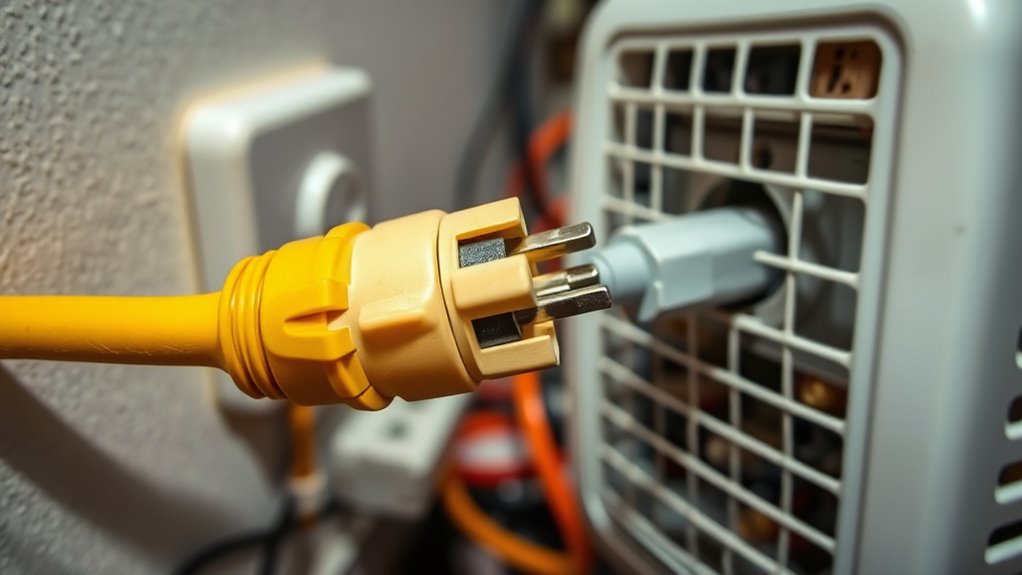
Recognizing safe and unsafe extension cord features is essential for preventing electrical hazards. First, check the cord insulation; it should be intact, thick, and free from cuts, cracks, or fraying. Damaged insulation exposes wires, increasing the risk of shocks or fires. Next, examine the plug integrity—look for sturdy, undamaged prongs that fit snugly into outlets. Loose or bent prongs can cause poor connections, overheating, or sparks. Avoid cords with extension cords that feel brittle or have visible damage. A safe extension cord will also have a grounding pin if needed, providing extra safety. Always choose cords labeled for indoor use if you’re plugging in a heater indoors. Recognizing these features helps you select a cord that minimizes risks and keeps your space safe. Additionally, regular inspection and cleaning of extension cords ensure they remain in good condition and function safely over time.
Ensuring Cord Condition and Maintenance

How can you guarantee your extension cords stay safe and reliable over time? Regularly inspect your cords for signs of cord deterioration, such as fraying or cracking. Ensure the plug integrity remains intact—look for loose or damaged prongs that could cause poor connections. Proper maintenance involves cleaning cords and avoiding sharp bends that strain the wiring. Additionally, understanding the importance of indoor air quality can help you appreciate the need for well-maintained cords to prevent hazards related to electrical malfunctions. To keep cords in top shape, remember: 1. Check for visible damage before each use, replacing any compromised cords. 2. Store cords properly, avoiding knots or twists that can cause internal damage. 3. Keep cords dry and away from moisture to prevent deterioration and electrical hazards.
Best Practices for Indoor and Outdoor Heater Connections

To guarantee safe and efficient operation of indoor and outdoor heaters, you should follow proper connection practices that minimize electrical hazards. Use outdoor extension cords specifically rated for weather exposure to prevent damage and reduce the risk of short circuits. Secure cords to prevent theft or accidental unplugging, especially in outdoor settings where cord theft can be a concern. Avoid overloading extension cords and never connect multiple cords together, which can cause overheating. Keep cords away from high-traffic areas to prevent tripping hazards. When possible, run cords along walls or fences to avoid damage. Protect outdoor cords from moisture and sunlight. Being aware of the best extension cord choices can further enhance safety and performance.
Emergency Tips and What to Do if an Issue Arises

If you notice sparks, smoke, or a burning smell, act immediately to prevent injury or fire. Disconnect the extension cord from the power source and keep others away from the area. Afterward, assess the situation carefully and contact emergency services if needed to guarantee everyone’s safety. Always remember to properly inspect your extension cords regularly to ensure they are in good condition and safe for use with heaters.
Immediate Danger Response
When an extension cord issue occurs, quick and calm action can prevent injuries and property damage. If you notice a spark, smoke, or smell burning, immediately unplug the cord to reduce the risk of fire hazard or electrical shock. Do not attempt to fix the problem yourself unless you’re qualified. Instead, follow these steps:
- Stay clear of the cord to avoid electrical shock or burns.
- Turn off the heater and power source to prevent further damage or fire.
- Call emergency services if you see flames or thick smoke, and evacuate if necessary.
- Always remember that proper electrical safety measures, including regular inspections, help prevent hazards related to extension cords and heating devices.
Reacting swiftly and cautiously minimizes danger, protects your safety, and prevents escalation of the incident. Always remember, safety first in any electrical emergency.
Post-Incident Safety Steps
After you’ve responded promptly to an extension cord emergency, taking proper safety steps afterward helps prevent further incidents and guarantees everyone’s well-being. Start by unplugging the cord and inspecting the damage. If there’s any sign of melting, exposed wiring, or burn marks, avoid using it again and schedule an electrical inspection. To reinforce fire prevention, keep the area clear of clutter and flammable materials. Check your heater and cords regularly for wear and tear, and replace damaged equipment immediately. Use this table as a reminder:
| Action | Purpose |
|---|---|
| Unplug and inspect | Prevents further damage |
| Schedule electrical inspections | Ensures safety compliance |
| Clear clutter, monitor cords | Reduces fire risk |
These steps help keep your space safe and prevent future hazards.
Frequently Asked Questions
Can I Connect Multiple Heaters With One Extension Cord Safely?
You shouldn’t connect multiple heaters with one extension cord, as it can overload the power load and damage the cord. A cord’s durability is vital, but even sturdy cords aren’t designed to handle the high current from multiple heaters. Overloading risks overheating and potential fires. Always use a heavy-duty extension cord rated for the combined power load, and ideally, plug each heater directly into separate outlets for safety.
How Do I Identify if an Extension Cord Is Rated for High Power Devices?
To identify if an extension cord is rated for high power devices, check its gauge and rating printed on the cord or packaging. Look for a lower gauge number, like 12 or 14, indicating thicker wiring suitable for high power. Also, verify the insulation quality is robust and rated for high wattage use. This guarantees your heater gets enough power safely without risking overheating or damage.
What Are Signs of an Extension Cord That Needs Replacement?
Like a battered knight’s armor, your extension cord shows signs when it’s time to replace it. Look for cord damage, frayed wiring, or scorch marks, which indicate deterioration. If the insulation is cracked or the plug feels loose, it’s a red flag. These issues can cause electrical shorts or fires, so don’t delay — swap out your cord to keep your space safe and your devices powered reliably.
Is It Safe to Leave Heaters Plugged in Overnight With Extension Cords?
No, it’s not safe to leave heaters plugged in overnight with extension cords. Extension cords with damaged cord insulation or excessive cord length can overheat and cause fires. Always use a properly rated, heavy-duty extension cord designed for heaters, and avoid running cords under carpets or rugs. For safety, plug heaters directly into wall outlets, and never leave them unattended while plugged in, especially overnight.
Are There Specific Extension Cords Recommended for Outdoor Heater Use?
For outdoor heater use, opt for sturdy, specially rated extension cords designed for outdoor environments. You should look for cords with a thicker cord gauge—at least 12 or 14 AWG—to handle higher power safely. Always prioritize indoor safety by choosing cords labeled for outdoor use, ensuring they’re weather-resistant and grounded. This prevents potential perils like overheating, short-circuiting, or sparks, keeping your outdoor setup safe and secure.
Conclusion
By following these simple tips, you’ll keep your heater safe and your home warm without risking a fire or shock. Think of it as your modern-day torch, lighting the way safely through the dark. Always choose the right cord, avoid overloads, and check for damage—don’t be a foolish pilgrim rushing into danger. Stay vigilant, maintain your cords, and remember, safety isn’t just a fad, it’s your best ally in a cozy, worry-free space.
